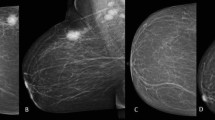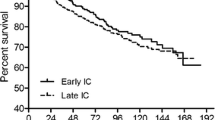Abstract
When mammography screening programs are fully implemented, interval cancers comprise a substantial proportion of incident breast cancers. Interval cancers may have been overlooked at the last mammography examination or become apparent because they grew so rapidly that the detectable preclinical phase (sojourn time) was shorter than the screening interval. This overview describes the epidemiology, radiological and biological characteristics and time of diagnosis of interval breast cancers in population of mammography screening. Our team retrospectively collected data of symptomatic patients who presented to the West Hertfordshire Trust Breast Unit during the period from 1st of October 2016 until the 30th of September 2017 and identified any interval cancers (screening imaging 40 months prior). Imaging included two-view digital mammogram as well as ultrasound. The total number of cancers diagnosed during this period was 335 patients of which a total of 49 patients (14.6%) were interval cancers, with an average age of 62.42 years; 48 patients (97.9%) had new cancers while one patient (2.1%) had recurrent disease, and 2 patients (4%) had metastatic disease.
Average tumour size was 26.79 mm (range 81 mm); 37 patients (75. 5%) had IDC with or without other pathology while average tumour grade was grade 2. Our review demonstrated that interval cancers are more common with invasive high-grade disease; multicentre further studies including larger numbers will be very informative.



Similar content being viewed by others
Abbreviations
- Bc:
-
breast cancer
- NHSBSP:
-
NHS Breast Screening Program
- DOA:
-
disclosure of audit
- DOC:
-
duty of candour
- MCC:
-
microcalcification
- IDC:
-
invasive ductal carcinoma
- ILC:
-
invasive lobular carcinoma
- DCIS:
-
ductal carcinoma in situ
- PLCIS:
-
pleomorphic lobular carcinoma in situ
- LVI:
-
lymphovascular invasion
- HR:
-
hormone receptors
- SLNB:
-
sentinel lymph node biopsy
- ALNC:
-
axillary lymph node clearance
- WLE:
-
wide local excision
- QA:
-
quality assurance
References
Ferlay J, Soerjomataram I, Dikshit R et al (2015) Cancer incidence and mortality worldwide: sources, methods and major patterns in globocan 2012. Int J Cancer 136:E359–E386. https://doi.org/10.1002/ijc.29210
Bulliard JL, Sasieni P, Klabunde C, De Landtsheer JP, Yankaskas BC, Fracheboud J (2006) Methodological issues in international comparison of interval breast cancers. Int J Cancer 119:1158–1163
Warren R, Duffy S (2000) Interval cancers as an indicator of performance in breast screening. Breast Cancer 7:9–18
Houssami N, Irwig L, Ciatto S (2006) Radiological surveillance of interval breast cancers in screening programmes. Lancet Oncol 7:259–265. https://doi.org/10.1016/S1470-2045(06)70617-9
Bucchi L et al (2008) Incidence of interval breast cancers after 650,000 negative mammographies in 13 Italian health districts. J Med Screen 15:30–35. https://doi.org/10.1258/jms.2008.007016
Andersen SB, Tornberg S, Lynge E, Von Euler-Chelpin M, Njor SH (2014) A simple way to measure the burden of interval cancers in breast cancer screening. BMC Cancer 14:782. https://doi.org/10.1186/1471-2407-14-782
Lowery JT, Byers T, Hokanson JE, Kittelson J, Lewin J, Risendal B, Singh M, Mouchawar J (2011) Complementary approaches to assessing risk factors for interval breast cancer. Cancer Causes Control 22:23–31. https://doi.org/10.1007/s10552-010-9663-x
Chiarelli AM et al (2006) Influence of patterns of hormone replacement therapy use and mammographic density on breast cancer detection. Cancer Epidemiol Biomark Prev 15:1856–1862. https://doi.org/10.1158/1055-9965.EPI-06-0290
Blanch J, Sala M, Ibáñez J, Domingo L, Fernandez B, Otegi A, Barata T, Zubizarreta R, Ferrer J, Castells X, Rué M, Salas D, for the INCA Study Group (2014) Impact of risk factors on different interval cancer subtypes in a population-based breast cancer screening programme. PLoS One 9:e110207. https://doi.org/10.1371/journal.pone.0110207
Boyd NF, Huszti E, Melnichouk O, Martin LJ, Hislop G, Chiarelli A, Yaffe MJ, Minkin S (2014) Mammographic features associated with interval breast cancers in screening programs. Breast Cancer Res 16:417. https://doi.org/10.1186/s13058-014-0417-7
NHS Breast Screening Programme Reporting, classification and monitoring of interval cancers and cancers following previous assessment August 2017
Taylor K, Britton P, O'Keeffe S, Wallis MG (2011) Quantification of the UK 5-point breast imaging classification and mapping to BI-RADS to facilitate comparison with international literature. Br J Radiol 84(1007):1005–1010. https://doi.org/10.1259/bjr/48490964
Collett K, Stefansson IM, Eide J, Braaten A, Wang H, Eide GE et al (2005) A basal epithelial phenotype is more frequent in interval breast cancers compared with screen detected tumours. Cancer Epidemiol BiomarkersPrev 14:1108–1112
Sihto H, Lundin J, Lehtimäki T (2008) Molecular subtypes of breast cancer detected in mammography screening and outside of screening. Clin Cancer Res 14:4103–4110
Kalager M, Tamimi RM, Bretthauer M, Adami H-O (2012) Prognosis in women with interval breast cancer: population based observational cohort study. BMJ 345. https://doi.org/10.1136/bmj.e7536
Dibden A et al (2014) Reduction in interval cancer rates following the introduction of two-view mammography in the UK breast screening programme. Br J Cancer 110:560–564. https://doi.org/10.1038/bjc.2013.778
Acknowledgements
We thank other radiologists in the Breast Unit Radiology Department for reporting mammograms and ultrasound scans.
Author information
Authors and Affiliations
Contributions
All authors were responsible for the ongoing patient’s care of the patient in the hospital, data collection, literature research and drafting the manuscript. SN and NJ were involved in patient’s diagnostics. All authors read and approved the final manuscript.
Corresponding author
Ethics declarations
Competing Interests
The authors declare that they have no competing interests.
Ethical Approval
No ethical approval was needed for this study as it is a retrospective analysis of standard practice.
Additional information
Publisher’s Note
Springer Nature remains neutral with regard to jurisdictional claims in published maps and institutional affiliations.
Rights and permissions
About this article
Cite this article
Monib, S., Narula, S. & Breunung-Joshi, N. Interval Breast Cancer Epidemiology, Radiology and Biological Characteristics. Indian J Surg 83 (Suppl 2), 328–332 (2021). https://doi.org/10.1007/s12262-019-01955-8
Received:
Accepted:
Published:
Issue Date:
DOI: https://doi.org/10.1007/s12262-019-01955-8




